
 BACK TO
BACK TO
FAIRLIGHT CMI
|
|
Where to Find Fairlight Samples and Sounds
Although I don't have samples on this site, you can look for them in several places:
- Patrick Fridh (aka Bitley) has worked hard to create an excellent Reason Refill package called
Fairlight CMI Legacy.
The samples were recorded from a Fairlight IIx with all Fairlight filtering disabled for maximum flexibility.
Patrick got approval from Fairlight AU and Fairlight Instruments (Peter Vogel himself) to use the samples.
Also included are synths like JX8P, DX7, VZ1 and more, plus some drum machines (Linndrum, 808, 909, 707) to make the library a journey into the 80s.
- The excellent
Hollow Sun
site has a bunch of free
Fairlight IIx samples
formatted for Akai S5/6000, Z4, Z8, and MPC4000.
They used some of my screen snapshots, with permission.
- Then there is the Sampling CD by JJ Jeczalik, "The Art of
Sampling". The CD booklet is layed out at
mattangert.tzo.com,
and it's available from
www.samples4.com.
- There's a Fairlight IIx sample CD available online from
Pro Rec.
It contains samples from the IIx library.
Pro Rec may not still have the right to sell this CD, so let your conscience guide you.
- The Fairlight CMI Users Group has an archive of audio and video files
here,
with a very cool custom FTP interface that looks kind of like Fairlight Page 2!
- There's a VST virtual instrument (MAC/PC) called
Cult Sampler
from
www.soundsonline.com
.
They used one of my screen snapshots on the virtual box without credit...
- Peter Vogel (co-founder of Fairlight) has been busy uploading some of his
archived tapes.
And here are some videos on YouTube:
|
The one thing that is clear from this collection of images is that no two
CMIs are alike. Many machines have been upgraded over the years -- some all
the way to the latest MFX.
In a nutshell: Series I and Series II use Motorola 6800 processors,
with the Series II having better voice cards. The Series IIx uses 6809
processors, while the Series III has 68000 processors and a stylus
instead of a lightpen, plus more memory, speed, disk space,
and double the voices.
The following images are low-resolution thumbnails.
Click on the image to open the full size version in a new window.
 |
KimRyrie_PeterVogel.jpg
200x221x8 26544 bytes
The caption appears to read: "Fairlight founders Kim Ryrie (left) and Peter Vogel with Series III Fairlight CMI".
The monitor looks like an early design, so this picture may have been taken around 1985.
Source: unknown
Also: Fairlight France:before.jpg |
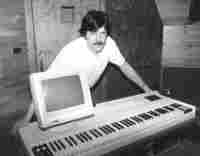 |
Peter_Vogel.jpg
549x429x24 31121 bytes
This image shows Peter Vogel leaning on a SIII keyboard in the Fairlight demo studio at the old Rushcutters Bay site. Just out of shot, to the right, is a Neve console. Behind Peter is the door to outside and the VO booth. Out of shot to the left is the VO booth window.
Judging by the newer monitor, this picture may have been taken around 1986. I am told that all SIII monitors are of the same physical and electrical design, but some were painted differently.
Source: Peter Vogel |
 |
the_fairlight_cmi.jpg
200x279x24 27972 bytes
This is probably a Series II. The full-width floppy drives suggest that it is an early model or an upgrade from a Series I. The screen is showing Page 4. Notice how the slave keyboard sits on the master keyboard.
Source: CD-ROM from French magazine, via David Vandenborn |
 |
fairlight_cmi_ii_flash.gif
288x318x8 38625 bytes
This is most likely a Series II, although it has the older full-width floppy drives. The "mountains and valleys" of the SAXY sample are visible on Page D. The lightning was probably the result of improper grounding!
Source: Fairlight brochure
Also: Fairlight France:cmi2.gif |
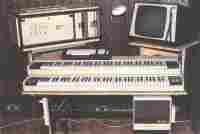 |
fairlight_cmi_ii_1.gif
350x234x8 69381 bytes
Another CMI with full-width floppy drives. However, this one has a new front panel so it is probably a Series IIx that was upgraded from a I or an early II.
Source: unknown
Also: Fairlight France:fair2.gif |
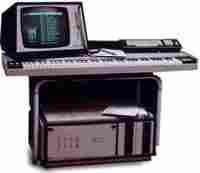 |
fairlight_cmi_ii_2.jpg
285x247x24 11948 bytes
This machine has the new front panel (without the baud rate selector), half-width floppy drives, and the Page 1 index screen shows 19 pages. So this is most likely a Series IIx from the factory, or an upgraded later-model II.
Source: unknown
Also: fairlight_cmi_iix.jpg
Also: Fairlight France:II.gif |
 |
fairlight_cmi_ii_card.jpg
419x279x24 54645 bytes
The drop-down front cover has been removed to show the circuit boards.
The extended card looks like the dual processor card, or the master card.
To the right of that you can see the eight voice cards, an empty slot, the lightpen interface, another empty slot or two, then the memory, floppy, and video cards.
Steve Rance of Fairlight ESP tells me that the extended card is actually the optional Analogue Interface Card, used for controlling external synths that conformed to the 1 volt per octave interface.
If it is, it's in the wrong slot! It should be in slot 11 just to the right of the voice cards, but it was placed in slot 2 just for the photo session.
It was chosen because at the time it was the most densely populated board as well as the last board that was made for the Series I. Not many were sold.
Note the full-width drives. Possibly a Series IIx that was upgraded from an earlier model.
Source: Fairlight brochure, via David Vandenborn |
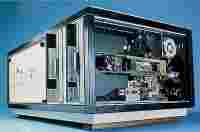 |
fairlight_cmi_ii_drives.jpg
411x272x24 60533 bytes
The end cover has been removed to show the mechanism of the full-width floppy drive. The disks need to be pushed in and the doors shut for it to work! The wooden rails, which serve as feet, are visible underneath the CMI. On the front panel, you can see the "Terminal Speed" knob, which is not on the new panel. This is a Series I or early II.
Source: CD-ROM from French magazine, via David Vandenborn |
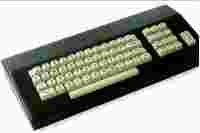 |
fairlight_cmi_ii_alpha.jpg
421x280x24 42047 bytes
The very solid alpha keyboard has a thick metal case. When powered, a relay provides a clicking sound when a key is pressed. The group of twelve keys to the right are the cursor keys, along with ADD, SUB, and SET. Farthest right is the RETURN key.
Source: Fairlight brochure, via David Vandenborn |
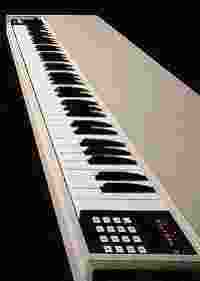 |
fairlight_cmi_ii_keyboard.jpg
199x280x24 21005 bytes
The Series I, II, and IIx keyboard has 73 keys. Easily visible is the 16-key calculator-style keypad with red LED display. At the far end are the two lighted switches and three sliders.
Source: Fairlight brochure, via David Vandenborn |
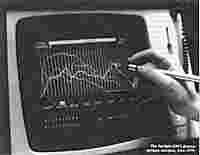 |
fairlight_cmi_ii_page4.jpg
200x155x8 10634 bytes
This shows the lightpen being used to draw harmonic profiles on an older version of Page 4. Compare to my page.
Source: unknown |
 |
fairlight_cmi_ii_page8.jpg
421x279x24 45962 bytes
The sampling page shows a "side view" of the waveform (in this case WHIRL), so you can see if the recording level is correct. Also, you can see the lightpen stored in its slot.
Source: Fairlight brochure, via David Vandenborn |
 |
floppydisk.jpg
423x282x24 42308 bytes
Here's the legendary "stack of source code". I have it on good authority that this stuff is real. (Or rather was real. I wonder where it is now?)
Source: Fairlight brochure |
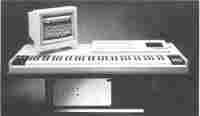 |
fairlight_cmi_iii_1.gif
297x172x8 42968 bytes
This machine has the Series III monitor, music and alpha keyboards, and front panel, but the system unit is a Series IIx case. This is one of the five Series III prototypes.
These machines had a few other odd features such as an analog section which had 8 channels per card, compared to production units with 2 channels per card.
Most of these original machines were converted to the later metalwork, with the newer style of output card.
The original idea was to fit all of the electronics into a series II frame.
This became impractical and so plug-in audio modules were used on the production Series III back panel.
Source: Fairlight brochure |
 |
fairlight_cmi_iii_2.jpg
200x282x24 16506 bytes
This may be the same machine that Kim and Peter are leaning on above. At least, it is showing the same screen image. There is no power switch below the drives, so this is an early Series III prototype.
The right end of the system unit is a bit too dark in this image, but there should be a hard drive there as shown more clearly below.
Source: CD-ROM from French magazine, via David Vandenborn |
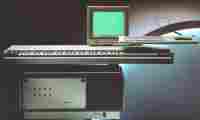 |
fairlight_cmi_iii_3.jpg
450x269x24 32648 bytes
This image attempts to prove that the CMI isn't really all that heavy! You can see the power switch and headphone controls below the disk drives. This is the sign of a genuine, production model, Series III.
Source: Fairlight brochure (1986) and poster
Also: Fairlight France:series3.jpg |
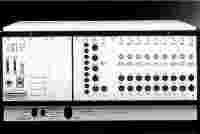 |
fairlight_cmi_iii_back.jpg
420x281x8 46109 bytes
The back of a genuine Series III, showing the printer, keyboard, and SCSI connectors on the left. In the middle are the many MIDI ports, sync and SMPTE connectors, and mixed line out. The sixteen separate outputs are on the right with the stereo sampling inputs. Along the bottom are the power sockets and serial number plaque.
Source: Fairlight brochure (1986) |
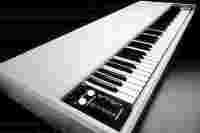 |
fairlight_cmi_iii_keyboard.jpg
420x279x8 40087 bytes
The Series III music keyboard includes two expression wheels, instead of the sliders on the Series II keyboard. The lighted switches are farther back than on the Series II.
Source: Fairlight brochure (1986) |
 |
fairlight_cmi_iii_stylus.jpg
420x281x8 48872 bytes
The Series III alpha keyboard is plastic instead of metal, and it includes a stylus and tablet to replace the lightpen. This eliminates the need to reach over to the monitor. The Real Time Effects page (equivalent to Page 7 on the Series II) is visible on the monitor, showing allocation of sub-voices (multi-sampling).
Source: Fairlight brochure (1986) |
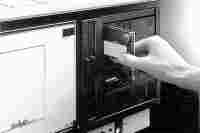 |
fairlight_cmi_iii_tape.jpg
419x279x8 42249 bytes
The standard Series III came with a 60MB hard drive and an optional 20MB "streaming" tape for backup. Also in this image you can see the power switch and headphone jack.
Source: Fairlight brochure (1986) |
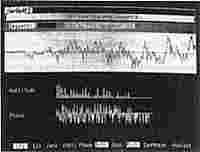 |
fairlight_cmi_iii_page6.jpg
200x152x8 14990 bytes
This image is so bad that I just had to include it, if only to prove that thumbnails sometimes look better than the full-sized images.
Source: unknown |
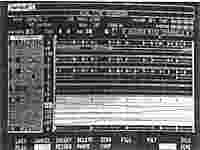 |
fairlight_cmi_iii_pager.jpg
200x150x8 15213 bytes
If you are sharp, you'll notice that this Series III "Real-Time Composer" screen has 16 rows of note information.
Source: unknown |
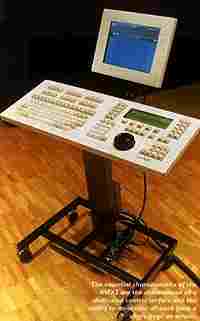 |
mfx3.jpg
200x321x24 31056 bytes
The Fairlight alpha keyboards keep getting bigger. This one needs its own stand! The CPU is basically a fully loaded Series III, and it is hiding off camera, at the other end of the black cable. The caption says "The essential characteristics of the MFX3 are the combination of a dedicated control surface and the ability to do almost all work from a single page on screen."
Source: unknown
Also: Fairlight France:after.jpg |
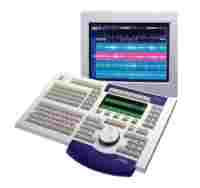 |
mfx3plus.gif
295x278x8 30983 bytes
The "Plus" model includes a more compact keyboard. "MFX" stands for "music and effects". As the Series III hard drives got larger, direct-to-disk recording started to make sense, along with SMPTE-triggered music cues and sound effects.
Source: unknown
Also: Fairlight France |
 |
cvi.jpg
419x195x24 26871 bytes
The Computer Video Instrument premiered in 1985 for around US$6500. It also came in black.
Source: CD-ROM from French magazine, via David Vandenborn |
Note
Many of the preceding images have been contributed by visitors to this
site. Most of them appear to be scans of brochures and other marketing
material originally created by the Fairlight company, or of other sources,
such as magazine articles. As such, the copyright of the images may be
owned by others, and their appearance on this site should be considered
"fair use", for educational purposes only. No infringement of copyright
is intended. If any copyright works have been used, please contact me
and the item(s) will be either removed or properly credited, at the
copyright owner's discretion.
|

